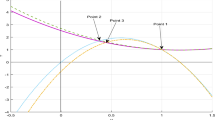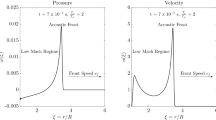Abstract
The structure of planar shock waves propagating through argon, xenon, and krypton is calculated using the direct simulation Monte Carlo method for Mach numbers 2, 5, and 10. The upstream temperature considered in the present paper varies from 30 to 8000 K, depending on the gas species and Mach number. Both quantum and classical approaches to the intermolecular collisions based on ab initio potential are used. The distributions of density and temperature inside the shock wave are reported. The density slope is calculated as a function of the upstream temperature and Mach number with the numerical error less than \(0.5\%\). The dependence of the density slopes on the upstream temperature is studied. It is shown that the slope behaviors of the heavy gases are qualitatively similar to each other, but they are completely different from those for helium.



Similar content being viewed by others
References
Gilbarg, D., Paolucci, D.: The structure of shock waves in the continuum theory of fluids. Arch. Ration. Mech. Anal. 2, 617–642 (1953)
Muckenfuss, C.: Some aspects of shock structure according to the bimodal model. Phys. Fluids 5, 1325–1336 (1962). https://doi.org/10.1063/1.1706528
Ohwada, T.: Structure of normal shock waves: direct numerical analysis of the Boltzmann equation for hard-sphere molecules. Phys. Fluids A 5, 217–234 (1993). https://doi.org/10.1063/1.858777
Koura, K.: Monte Carlo direct simulation of rotational relaxation of diatomic molecules using classical trajectory calculations: nitrogen shock wave. Phys. Fluids 9, 3543–3549 (1997). https://doi.org/10.1063/1.869462
Elizarova, T., Shirokov, I., Montero, S.: Numerical simulation of shock-wave structure for argon and helium. Phys. Fluids 17, 068101 (2005). https://doi.org/10.1063/1.1921267
Stefanov, S.: On DSMC calculations of rarefied gas flows with small number of particles in cells. SIAM J. Sci. Comput. 33, 677–702 (2011). https://doi.org/10.1137/090751864
Norman, P., Valentini, P., Schwartzentruber, T.: GPU-accelerated classical trajectory calculation direct simulation Monte Carlo applied to shock waves. J. Comput. Phys. 247, 153–167 (2013). https://doi.org/10.1016/j.jcp.2013.03.060
Bird, G.A.: Aspects of the structure of strong shock waves. Phys. Fluids 13, 1172–1177 (1970). https://doi.org/10.1063/1.1693047
Bird, G.A.: The DSMC Method. Create Space Independent Publishing Platform, Scotts Valley (2013)
Dodulad, O.I., Tcheremissine, F.G.: Computation of a shock wave structure in monatomic gas with accuracy control. Comput. Math. Math. Phys. 53, 827–844 (2013). https://doi.org/10.1134/S0965542513060055
Bruno, D., Frezzotti, A., Ghiroldi, G.P.: Oxygen transport properties estimation by classical trajectory-direct simulation Monte Carlo. Phys. Fluids 27, 057 101 (2015). https://doi.org/10.1063/1.4921157
Malkov, E., Bondar, Y.A., Kokhanchik, A., Poleshkin, S., Ivanov, M.: High-accuracy deterministic solution of the Boltzmann equation for the shock wave structure. Shock Waves 25, 387–397 (2015). https://doi.org/10.1007/s00193-015-0563-6
Sharipov, F., Dias, C.F.: Ab initio simulation of planar shock waves. Comput. Fluids 150, 115–122 (2017). https://doi.org/10.1016/j.compfluid.2017.04.002
Sharipov, F., Dias, C.F.: Structure of planar shock waves in gaseous mixtures based on ab initio direct simulation. Eur. J. Mech. B Fluids 72, 251–263 (2018). https://doi.org/10.1016/j.euromechflu.2018.05.014
Sharipov, F., Dias, C.F.: Temperature dependence of shock wave structure in helium and neon. Phys. Fluids 31, 037 109 (2019). https://doi.org/10.1063/1.5088556
Cowan, G.R., Hornig, D.F.: The experimental determination of the thickness of a shock front in a gas. J. Chem. Phys. 18, 1008–1018 (1950). https://doi.org/10.1063/1.1747845
Greene, E.F., Cowan, G.R., Hornig, D.F.: The thickness of shock fronts in argon and nitrogen and rotational heat capacity lags. J. Chem. Phys. 19, 427–434 (1951). https://doi.org/10.1063/1.1748241
Robben, F., Talbot, L.: Measurement of shock wave thickness by the electron beam fluorescence method. Phys. Fluids 9, 633–643 (1966). https://doi.org/10.1063/1.1761728
Schmidt, B.: Electron beam density measurements in shock waves in argon. J. Fluid Mech. 39, 361–373 (1969). https://doi.org/10.1017/S0022112069002229
Alsmeyer, H.: Density profiles in argon and nitrogen shock waves measured by absorption of an electron beam. J. Fluid Mech. 74, 497–513 (1976). https://doi.org/10.1017/S0022112076001912
Linzer, M., Hornig, D.: Structure of shock fronts in argon and nitrogen. Phys. Fluids 6, 1661–1668 (1963). https://doi.org/10.1063/1.1711007
Moore, A.S., Lazarus, J., Hohenberger, M., Robinson, J.S., Gumbrell, E.T., Dunne, M., Smith, R.A.: Investigating the astrophysical applicability of radiative and non-radiative blast wave structure in cluster media. Astrophys. Space Sci. 307, 139–145 (2007). https://doi.org/10.1007/s10509-006-9266-x
González, M., Stehlé, C., Audit, E., Busquet, M., Rus, B., Thais, F., Acef, O., Barroso, P., Bar-Shalom, A., Bauduin, D., Kozlova, M., Lery, T., Madouri, A., Mocek, T., Polan, J.: Astrophysical radiative shocks: from modeling to laboratory experiments. Laser Part. Beams 24, 535–540 (2006). https://doi.org/10.1017/S026303460606071X
Hanley, H.: The viscosity and thermal conductivity coefficients of dilute argon, krypton, and xenon. J. Phys. Chem. Ref. Data 2, 619–642 (1973). https://doi.org/10.1063/1.3253128
Murthy, M.K., Ramachandra, S.M.: Ionizing shock waves in monatomic gases through a kinetic theory approach. Acta Astronaut. 2, 367–389 (1975). https://doi.org/10.1016/0094-5765(75)90056-9
Chubb, D.L.: Ionizing shock structure in a monatomic gas. Phys. Fluids 11, 2363–2376 (1968). https://doi.org/10.1063/1.1691826
Rodriguez, R., Gil, J.M., Espinosa, G., Florido, R., Rubiano, J.G., Mendoza, M.A., Martel, P., Minguez, E., Symes, D.R., Hohenberger, M., Smith, R.A.: Determination and analysis of plasma parameters for simulations of radiative blast waves launched in clusters of xenon and krypton. Plasma Phys. Control. Fusion 54, 045012 (2012). https://doi.org/10.1088/0741-3335/54/4/045012
Rodriguez, R., Gil, J.M., Espinosa, G., Florido, R., Mendoza, M.A., Martel, P., Minguez, E., Symes, D.R., Hohenbergerd, M., Smith, R.A.: Determination and analysis of plasma radiative properties for numerical simulations of laboratory radiative blast waves launched in xenon clusters. J. Spectrosc. Dyn. 3, 17 (2013)
Matthew, M., Steinwandel, J.: An experimental-study of argon condensation in cryogenic shock-tubes. J. Aerosol. Sci. 14, 755–763 (1983). https://doi.org/10.1016/0021-8502(83)90059-9
Sharipov, F.: Modelling of transport phenomena in gases based on quantum scattering. Phys. A 508, 797–805 (2018). https://doi.org/10.1016/j.physa.2018.05.129
Newell, D.B., Cabiati, F., Fischer, J., Fujii, K., Karshenboim, S.G., Margolis, H.S., de Mirandes, E., Mohr, P.J., Nez, F., Pachucki, K., Quinn, T.J., Taylor, B.N., Wang, M., Wood, B.M., Zhang, Z.: The CODATA 2017 values of \(h\), \(e\), \(k\), and \(N_A\) for the revision of the SI. Metrologia 55, L13–L16 (2018). https://doi.org/10.1088/1681-7575/aa950a
Sharipov, F., Benites, V.: Transport coefficients of argon and its mixtures with helium and neon at low density based ab initio potentials. Fluid Phase Equilib. 498, 23–32 (2019). https://doi.org/10.1016/j.fluid.2019.06.010
Jäger, B., Hellmann, R., Bich, E., Vogel, E.: State-of-the-art ab initio potential energy curve for the krypton atom pair and thermophysical properties of dilute krypton gas. J. Chem. Phys. 144, 114 304 (2016). https://doi.org/10.1063/1.4943959
Hellmann, R., B, J., Bich, E.: State-of-the-art ab initio potential energy curve for the xenon atom pair and related spectroscopic and thermophysical properties. J. Chem. Phys. 147, 034 304 (2017). https://doi.org/10.1063/1.4994267
Kandula, D.Z., Gohle, C., Pinkert, T.J., Ubachs, W., Eikema, K.S.E.: Extreme ultraviolet frequency comb metrology. Phys. Rev. Lett. 105, 063001 (2010). https://doi.org/10.1103/PhysRevLett.105.063001
Saloman, E.B., Sansonetti, C.J.: Wavelengths, energy level classifications, and energy levels for the spectrum of neutral neon. J. Phys. Chem. Ref. Data 33, 1113–1158 (2007). https://doi.org/10.1063/1.1797771
Velchev, I., Hogervorst, W., Ubachs, W.: Precision VUV spectroscopy of ArI at 105 nm. J. Phys. B At. Mol. Opt. Phys. 32, L511–L516 (1999). https://doi.org/10.1088/0953-4075/32/17/105
Saloman, E.B.: Energy levels and observed spectral lines of krypton, Kr I through Kr XXXVI. J. Phys. Chem. Ref. Data 36, 215–386 (2007). https://doi.org/10.1063/1.2227036
Saloman, E.B.: Energy levels and observed spectral lines of xenon, Xe I through Xe LIV. J. Phys. Chem. Ref. Data 33, 765–921 (2007). https://doi.org/10.1063/1.1649348
Lideed, D.R.: Handbook of Chemistry and Physics, 85th edn. CRC Press, Boca Raton (2005)
Sharipov, F.: Rarefied Gas Dynamics. Fundamentals for Research and Practice. Wiley-VCH, Berlin (2016). https://doi.org/10.1002/9783527685523
Meija, J., Coplen, T.B., Berglund, M., Brand, W.A., De Bievre, P., Groning, M., Holden, N.E., Irrgeher, J., Loss, R.D., Walczyk, T., Prohaska, T.: Isotopic composition of the elements 2013 (IUPAC Technical Report). Pure Appl. Chem. 88, 293–306 (2016). https://doi.org/10.1515/pac-2015-0503
Sharipov, F.: Gaseous mixtures in vacuum systems and microfluidics. J. Vac. Sci. Technol. A 31, 050 806 (2013). https://doi.org/10.1116/1.4808496
Sharipov, F., Cumin, L.M.G., Kalempa, D.: Plane Couette flow of binary gaseous mixture in the whole range of the Knudsen number. Eur. J. Mech. B Fluids 23, 899–906 (2004). https://doi.org/10.1016/j.euromechflu.2004.03.002
Sharipov, F.: Influence of quantum intermolecular interaction on internal flows of rarefied gases. Vacuum 156, 146–153 (2018). https://doi.org/10.1016/j.vacuum.2018.07.022
Sharipov, F., Strapasson, J.L.: Direct simulation Monte Carlo method for an arbitrary intermolecular potential. Phys. Fluids 24, 011 703 (2012). https://doi.org/10.1063/1.3676060
Ferziger, J.H., Kaper, H.G.: Mathematical Theory of Transport Processes in Gases. North-Holland Publishing Company, Amsterdam (1972)
Joachain, J.: Quantum Collision Theory. North-Holland Publishing Company, Amsterdam (1975)
Sharipov, F., Benites, V.: Transport coefficients of helium-neon mixtures at low density computed from ab initio potentials. J. Chem. Phys. 147, 224 302 (2017). https://doi.org/10.1063/1.5001711
Jäger, B., Hellmann, R., Bich, E., Vogel, E.: Ab initio pair potential energy curve for the argon atom pair and thermophysical properties of the dilute argon gas. I. Argon–argon interatomic potential and rovibrational spectra. Mol. Phys. 107, 2181–2188 (2009). https://doi.org/10.1080/00268970903213305. erratum in Mol. Phys. 108, 105 (2010)
Patkowski, K., Szalewicz, K.: Argon pair potential at basis set and excitation limits. J. Chem. Phys. 133, 094 304 (2010). https://doi.org/10.1063/1.3478513
Sharipov, F., Strapasson, J.L.: Ab initio simulation of transport phenomena in rarefied gases. Phys. Rev. E 86, 031130 (2012). https://doi.org/10.1103/PhysRevE.86.031130
Ferreira, A.G.M., Lobo, L.Q.: The sublimation of argon, krypton, and xenon. J. Chem. Thermodyn. 40, 1621–1626 (2008). https://doi.org/10.1016/j.jct.2008.07.023
Acknowledgements
F.Sh. acknowledges the Brazilian Agency CNPq for the support of his research, Grant 304831/2018-2. F.C.D. thanks the Brazilian Agency CAPES for her Ph.D. Scholarship. The calculations were carried out at Centro Nacional de Supercomputação (CESUP) of Federal University of Rio Grande do Sul.
Author information
Authors and Affiliations
Corresponding author
Additional information
Communicated by S. O’Byrne.
Publisher's Note
Springer Nature remains neutral with regard to jurisdictional claims in published maps and institutional affiliations.
This paper is based on work that was presented at the 32nd International Shock Wave Symposium, Singapore, July 14–July 19, 2019.
Electronic supplementary material
Below is the link to the electronic supplementary material.
Rights and permissions
About this article
Cite this article
Dias, F.C., Sharipov, F. The structure of shock waves propagating through heavy noble gases: temperature dependence. Shock Waves 31, 609–617 (2021). https://doi.org/10.1007/s00193-020-00965-w
Received:
Revised:
Accepted:
Published:
Issue Date:
DOI: https://doi.org/10.1007/s00193-020-00965-w




